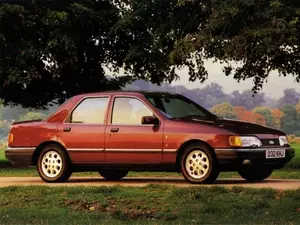
| Vehicle | Precise engine size | Difference from world average | Engine size to consumption ratio | Horsepower from 1 L | Engine size to 100 kg of weight |
|---|---|---|---|---|---|
| 2.0i |
2 L (1998 cc) |
14.8% smaller | 71 cc to 1 mpg | 63 hp from 1 L | 167 cc to 100 kg |
| Vehicle | 2.0i |
|---|---|
| Precise engine size | 2 L (1998 cc) |
| Difference from world average | 14.8 smaller |
| Engine size to consumption ratio | 71 cc to 1 mpg |
| Horsepower from 1 L | 63 hp from 1 L |
| Engine size to 100 kg of weight | 167 cc to 100 kg |

| Vehicle | Precise engine size | Difference from world average | Engine size to consumption ratio | Horsepower from 1 L | Engine size to 100 kg of weight |
|---|---|---|---|---|---|
| 2.0i |
2 L (1998 cc) |
14.8% smaller | - | 60 hp from 1 L | - |
| 1.8 |
1.8 L (1796 cc) |
23.4% smaller | - | 44 hp from 1 L | - |
| 1.8 TD |
1.75 L (1753 cc) |
25.3% smaller | - | 43 hp from 1 L | - |
| 2.0 |
1.99 L (1993 cc) |
15% smaller | - | 53 hp from 1 L | - |
| 1.6 |
1.6 L (1597 cc) |
31.9% smaller | - | 45 hp from 1 L | - |
| 1.6 i |
1.6 L (1597 cc) |
31.9% smaller | - | 56 hp from 1 L | - |
| 2.9 i XR 4x4 |
2.93 L (2933 cc) |
25% bigger | - | 51 hp from 1 L | - |
| 2.9 i |
2.93 L (2933 cc) |
25% bigger | - | 49 hp from 1 L | - |
| Vehicle | 2.0i |
|---|---|
| Precise engine size | 2 L (1998 cc) |
| Difference from world average | 14.8 smaller |
| Engine size to consumption ratio | - |
| Horsepower from 1 L | 60 hp from 1 L |
| Engine size to 100 kg of weight | - |
| Vehicle | 1.8 |
| Precise engine size | 1.8 L (1796 cc) |
| Difference from world average | 23.4 smaller |
| Engine size to consumption ratio | - |
| Horsepower from 1 L | 44 hp from 1 L |
| Engine size to 100 kg of weight | - |
| Vehicle | 1.8 TD |
| Precise engine size | 1.75 L (1753 cc) |
| Difference from world average | 25.3 smaller |
| Engine size to consumption ratio | - |
| Horsepower from 1 L | 43 hp from 1 L |
| Engine size to 100 kg of weight | - |
| Vehicle | 2.0 |
| Precise engine size | 1.99 L (1993 cc) |
| Difference from world average | 15 smaller |
| Engine size to consumption ratio | - |
| Horsepower from 1 L | 53 hp from 1 L |
| Engine size to 100 kg of weight | - |
| Vehicle | 1.6 |
| Precise engine size | 1.6 L (1597 cc) |
| Difference from world average | 31.9 smaller |
| Engine size to consumption ratio | - |
| Horsepower from 1 L | 45 hp from 1 L |
| Engine size to 100 kg of weight | - |
| Vehicle | 1.6 i |
| Precise engine size | 1.6 L (1597 cc) |
| Difference from world average | 31.9 smaller |
| Engine size to consumption ratio | - |
| Horsepower from 1 L | 56 hp from 1 L |
| Engine size to 100 kg of weight | - |
| Vehicle | 2.9 i XR 4x4 |
| Precise engine size | 2.93 L (2933 cc) |
| Difference from world average | 25 bigger |
| Engine size to consumption ratio | - |
| Horsepower from 1 L | 51 hp from 1 L |
| Engine size to 100 kg of weight | - |
| Vehicle | 2.9 i |
| Precise engine size | 2.93 L (2933 cc) |
| Difference from world average | 25 bigger |
| Engine size to consumption ratio | - |
| Horsepower from 1 L | 49 hp from 1 L |
| Engine size to 100 kg of weight | - |

| Vehicle | Precise engine size | Difference from world average | Engine size to consumption ratio | Horsepower from 1 L | Engine size to 100 kg of weight |
|---|---|---|---|---|---|
| 1.6 |
1.6 L (1597 cc) |
31.9% smaller | - | 47 hp from 1 L | - |
| 2.0 |
2 L (1998 cc) |
14.8% smaller | - | 45 hp from 1 L | - |
| 1.8 |
1.8 L (1796 cc) |
23.4% smaller | - | 50 hp from 1 L | - |
| 2.0i |
1.99 L (1993 cc) |
15% smaller | - | 58 hp from 1 L | - |
| 2.3 |
2.29 L (2294 cc) |
2.2% smaller | - | 50 hp from 1 L | - |
| 2.3 D |
2.3 L (2304 cc) |
1.8% smaller | - | 29 hp from 1 L | 192 cc to 100 kg |
| 2.8 XR4i |
2.79 L (2792 cc) |
19% bigger | - | 54 hp from 1 L | - |
| Vehicle | 1.6 |
|---|---|
| Precise engine size | 1.6 L (1597 cc) |
| Difference from world average | 31.9 smaller |
| Engine size to consumption ratio | - |
| Horsepower from 1 L | 47 hp from 1 L |
| Engine size to 100 kg of weight | - |
| Vehicle | 2.0 |
| Precise engine size | 2 L (1998 cc) |
| Difference from world average | 14.8 smaller |
| Engine size to consumption ratio | - |
| Horsepower from 1 L | 45 hp from 1 L |
| Engine size to 100 kg of weight | - |
| Vehicle | 1.8 |
| Precise engine size | 1.8 L (1796 cc) |
| Difference from world average | 23.4 smaller |
| Engine size to consumption ratio | - |
| Horsepower from 1 L | 50 hp from 1 L |
| Engine size to 100 kg of weight | - |
| Vehicle | 2.0i |
| Precise engine size | 1.99 L (1993 cc) |
| Difference from world average | 15 smaller |
| Engine size to consumption ratio | - |
| Horsepower from 1 L | 58 hp from 1 L |
| Engine size to 100 kg of weight | - |
| Vehicle | 2.3 |
| Precise engine size | 2.29 L (2294 cc) |
| Difference from world average | 2.2 smaller |
| Engine size to consumption ratio | - |
| Horsepower from 1 L | 50 hp from 1 L |
| Engine size to 100 kg of weight | - |
| Vehicle | 2.3 D |
| Precise engine size | 2.3 L (2304 cc) |
| Difference from world average | 1.8 smaller |
| Engine size to consumption ratio | - |
| Horsepower from 1 L | 29 hp from 1 L |
| Engine size to 100 kg of weight | 192 cc to 100 kg |
| Vehicle | 2.8 XR4i |
| Precise engine size | 2.79 L (2792 cc) |
| Difference from world average | 19 bigger |
| Engine size to consumption ratio | - |
| Horsepower from 1 L | 54 hp from 1 L |
| Engine size to 100 kg of weight | - |